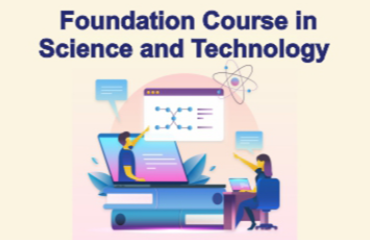Foundation
Course in Science and Technology
Data science is one of
the best-suited professions to thrive this century. It is digital,
programming-oriented, and analytical. Therefore, it is no surprise that the
demand for data scientists has been surging in the job marketplace.
However, supply has
been minimal. Acquiring the skills necessary to be hired as a data scientist
isn't easy.
And how can you do
that?
Universities have been
slow to create specialized data science programs. (not to mention that the ones
that exist are costly and time-consuming)
Most online courses
focus on a specific topic and it isn't easy to understand how their teaching
skills fit into the picture.
The
Solution
Data science is a
multidisciplinary field. It encompasses a wide range of topics.
- Understanding of the data science field and the type of
analysis carried out
- Mathematics
- Statistics
- Python
- Applying advanced statistical techniques in
Python
- Data Visualization
- Machine Learning
- Deep Learning
Each of these topics builds
on the previous ones. And you risk getting lost along the way if you don’t
acquire these skills in the correct order. For example, one would struggle to
apply Machine Learning techniques before understanding the underlying
Mathematics. Or, it can be overwhelming to study regression analysis in Python
before knowing what a regression is.
So,
to create the most effective, time-efficient, and structured data science
training available online, we made The Data Science Course 2023.
We believe this is the
first training program that solves the biggest challenge to entering the data
science field – having all the necessary resources in one place.
Moreover, our focus is
to teach topics that flow smoothly and complement each other. The course
teaches you everything you need to know to become a data scientist at a
fraction of the cost of traditional programs (not to mention the amount of time
you will save).
The
Skills
1. Intro to Data and Data Science
Big data, business
intelligence, business analytics, machine learning and artificial intelligence.
We know these buzzwords belong to the field of data science, but what do they
all mean?
Why
learn it? As a candidate
data scientist, you must understand the ins and outs of each of these areas and
recognize the appropriate approach to solving a problem. This ‘Intro to Data
and Data Science’ will give you a comprehensive look at all these buzzwords and
where they fit in data science.
2.
Mathematics
Learning the tools is
the first step to doing data science. You must first see the big picture to
examine the parts in detail.
We look specifically
at calculus and linear algebra as they are the subfields data science relies
on.
Why
learn it?
Calculus and linear
algebra are essential for programming in data science. You need these skills in
your arsenal to understand advanced machine-learning algorithms.
3.
Statistics
It would be best if
you thought like a scientist before you can become a scientist. Statistics
trains your mind to frame problems as hypotheses and gives you techniques to
test these hypotheses, just like a scientist.
Why
learn it?
This course doesn’t
just give you the tools you need but teaches you how to use them. Statistics
trains you to think like a scientist.
4.
Python
Python is a relatively
new programming language and, unlike R, it is a general-purpose programming
language. You can do anything with it! Web applications, computer games and
data science are among its capabilities. That’s why, in a short time, it has disrupted
many disciplines. Compelling libraries have been developed for data
manipulation, transformation, and visualization. However, Python shines when it
deals with machine learning and deep learning.
Why
learn it?
When developing,
implementing, and deploying machine learning models through powerful frameworks
such as scikit-learn, TensorFlow, etc., Python is a must-have programming
language.
5.
Tableau
Data scientists don’t
just need to deal with data and solve data-driven problems. They also need to
convince company executives of the right decisions to make. These executives
may not be well versed in data science, so the data scientist must be able to
present and visualize the data’s story in a way they will understand. That’s
where Tableau comes in – and we will help you become an expert storyteller
using the leading visualization software in business intelligence and data
science.
Why
learn it?
A data scientist
relies on business intelligence tools like Tableau to communicate complex
results to non-technical decision-makers.
6.
Advanced Statistics
Regressions,
clustering, and factor analysis were all disciplines invented before machine
learning. However, these statistical methods are now performed through machine
learning to provide predictions with unparalleled accuracy. This section will
look at these techniques in detail.
Why
learn it?
Data science is all
about predictive modeling; you can become an expert in these methods through
this ‘advanced statistics’ section.
7.
Machine Learning
The final part of the
program and what every section has been leading up to, is deep learning. Being
able to employ machine and deep learning in their work is what often separates
a data scientist from a data analyst. This
section covers all common machine learning techniques and deep learning methods
with TensorFlow.
Why
learn it?
Machine learning is
everywhere. Companies like Facebook, Google, and Amazon have been using
machines that can learn independently for years. Now is the time for you to
control the devices.
Who this
course is for:
·
You should take this course if you want to become a Data
Scientist or if you want to learn about the field
·
This course is for you if you want a great career
·
The course is also ideal for beginners, as it starts from the
fundamentals and gradually builds up your skills

